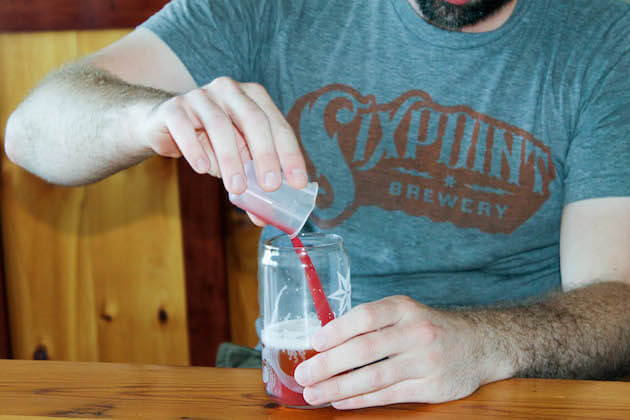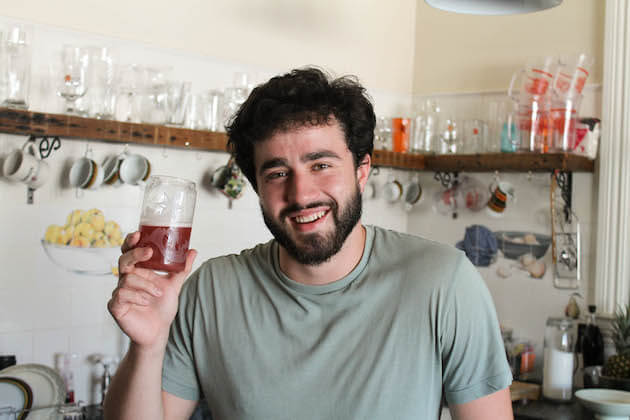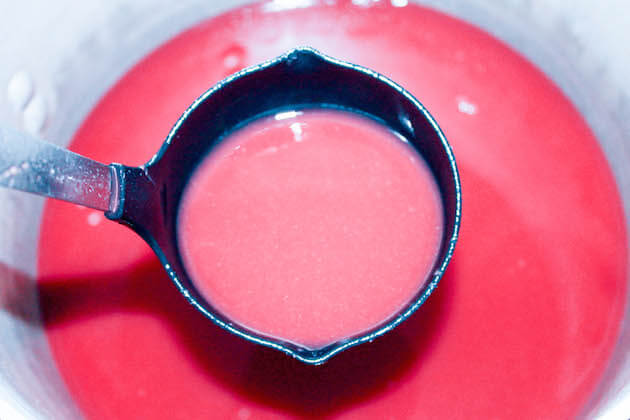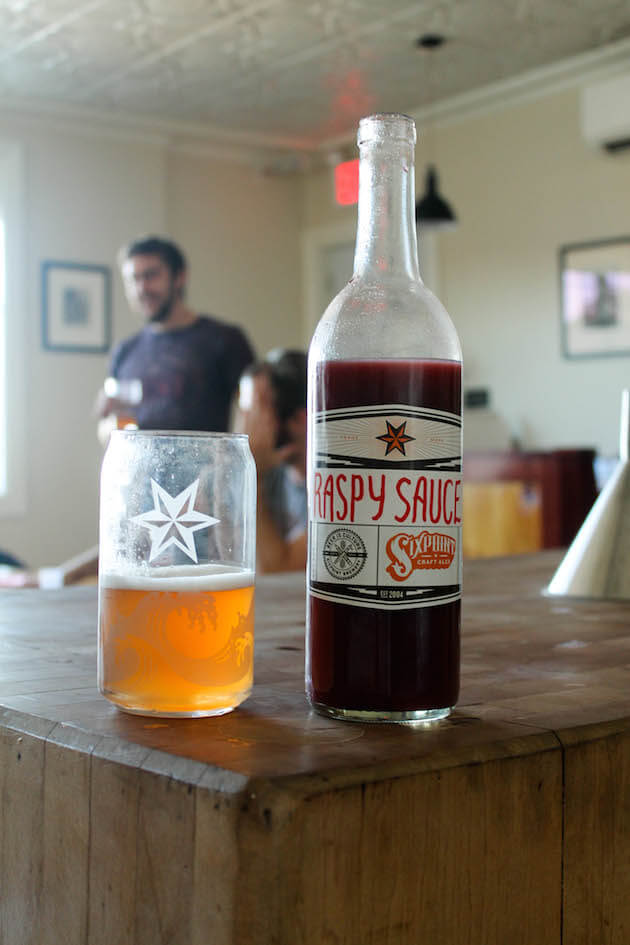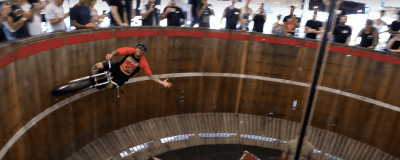Berliner Weisse + Serrano-Raspberry Jam = Sixpoint’s Little Raspy, A New Experiment in the ‘Beer and Shot’ Combo
Nothing puts me more at ease after a long day of work than a beer and a shot combo. Usually, these offerings are on the cheaper end of the spectrum–a sweaty bottle of Bud or can of PBR accompanied by a short pour of lukewarm well whiskey, served with a knowing wink from the barkeep. Having two vessels at my total discretion gives me a sense of wholeness, a sense of choice and sovereignty–do I shoot the whiskey quickly, easing the burn with an immediate steady stream of cold, refreshing brew? Or do I sip the amber-colored elixir slowly, letting the booze’s caramel sweetness drench my palate before washing it away with a cleansing wave of ultra-carbonated beer? Either way, it’s completely, 100 percent up to me.
Sixpoint’s Mikey Lenane shares my affection for consumer-powered concoctions, one of the driving factors behind Little Raspy, Sixpoint’s newest limited release Berliner Weisse, out this week at select bars around New York City. Raspy, a super tart kettle sour brewed with a puckery dose of bright red raspberry puree, is served in the traditional German style with a sidecar of fruity syrup, transforming each drinker into a mad scientist set against the backdrop of a barroom laboratory. By adding small (or large) doses of the syrup, the patron can control the color and the flavor of the beverage, tempering the Berliner’s acidity with the juicy, soothing powers of sweet fruit.
While the serving methods might be traditional, in true Sixpoint, buck-the-system style, little else about Raspy falls under classic guidelines–most notably the addition of earthy, spicy serrano peppers to the homemade syrup, a recipe based on a jalapeno-raspberry jam put out by Brooklyn’s beloved Jam Stand. I sat down with Lenane earlier this week to get the skinny on this new experiment in independently minded drinking and collaboration with Jam Stand.
When did you first come in contact with a traditional Berliner Weisse?
I think it was probably at DSK in Fort Greene that I first had a Berliner Weiss, and it was pretty good — it didn’t taste like cough syrup or anything like some of the watered down ones you can, but I remember thinking it could be better.
Then, when I started thinking about it, I realized you could put anything it. Like the traditional ones, they’re just doing two things: raspberry and woodruff, but, you know, we could do anything we want!
So that’s kind of when the idea for Little Raspy was born?
Well I’ve been tossing the idea around for about two years now. At first, I didn’t know how well the sourness and the heat would go together, but tasting it today, I think they work fantastically. You get this serious, lasting heat that really nicely adds to the long, puckering finish of the Berliner.
I thought it would make a good Mad Scientist beer, but it’s not quite there yet. The physical dissemination of the sauce is still a big thing to figure out in terms of packaging and distributing, so we’re testing it out. But I think it’s a cool idea.
Why did you choose to work with the Jam Stand?
We made the syrup based off this jam they do with raspberries and Jalapenos, one we’ve actually already brewed a beer with it, a Belgian beer that ended up being one of our best received Mad Scientists. Now, with Little Raspy, we’re kind taking it further, because when you brew with the jam, you ferment out all the sugars in the raspberry so it just becomes very tart. Adding it back in as a syrup, we can actually feature some of that raspberry sweetness.
They also just make awesome jam and they’re cool and friends of ours.
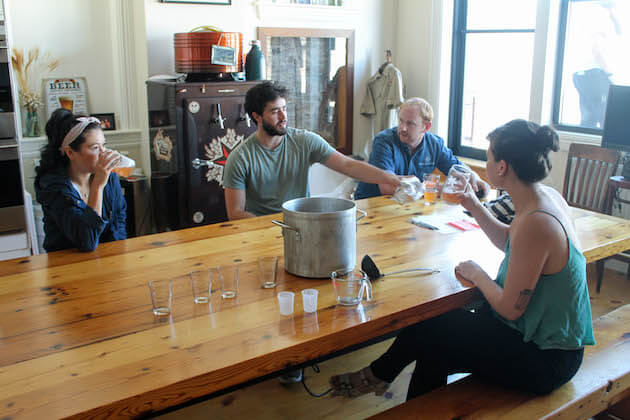

Jessica Quon and Sabrina Valle from Jam Stand try out the Little Raspy with Michael Lenane and others from Sixpoint.
Why serranos and not jalapenos?
Another person who’s been into this idea for awhile is my uncle, who owns a restaurant upstate. At the restaurant, they do some spicy cocktails, and he loves serrano peppers. I remember I was kicking the idea around with him one night and he was drinking some gin drink with whole slices of serrano peppers floating around in there. He was even eating them, too. I was like, “Alright, we have to use these serranos.”
How does it taste different than a jalapeno?
It has more of a vegetal character. They both have the same gentle heat, but the Serrano is maybe a little more citric, less sharp. It’s still really spicy, probably even spicier than a Jalapeno.
We made the sauce earlier today. I was taking out the middles of the peppers, cutting them up and chucking them in the sauce–we threw them in halved and fished them out once we got to the desired flavor.
I hope you were wearing gloves.
Well, that’s the thing. It was nearing the end of the day and our founder was coming in later so the brewery had to be extra spic and span. So we’re running around, hustling and sweating like crazy and I start wiping my face with my shirt, and I definitely got some of the oil on there. So, by the end of the day, I’m freaking out, my cheeks were super rosy and swollen. My hands are still burning a little bit. But, you know, the sauce tastes really good!
Yikes. So what’s the sweetest to spiciness ratio?
So raspberries, you’ll notice when you work with them, their pH is like 3.6–they’re sour. We started out looking at a simple syrup recipe, but that ended up being too sweet. [Sixpoint brewer] Kier, he was a bartender for a long time, so he’s familiar with making syrups and all that kind of stuff, so we messed around with that and ended up making it considerably less sweet than a simple syrup, about two-fifths as sweet. And then we just steeped in some serranos, got their raw flavor, and then added back some raspberry puree from Red Jacket to round it out.
The sauce turned out awesome–you get some great raw raspberry flavor and you get these nice herbal, vegetal notes from the Serrano. You actually don’t notice the heat for awhile because the Berliner Weisse we’re putting it in is really very sour. Since I’ve started working here, it’s the most sour beer we’ve made, pretty considerably. The base beer got down to a 3.2 pH, so you’re looking at considerably more sour than you’re average, easy drinking kettle sour.
Sound delicious. How’s it going to work in bars?
So far, some pretty cool bars seem really interested in it, like Proletariat, Blind Tiger and Hops Hill. We’ve got sixteen sixtels of Berliner and six bottles of syrup and we’re planning to work out the proportions so we can recommend to bars exactly how to serve it.
Distribution-wise, it’s actually super simple and super cheap. We packaged the syrup, we’re calling it Raspy Sauce, in clear homebrew bottles and [Sixpoint graphic designer] Jack made some custom drawings for the labels. We’re going to attach a bartender spout to it, just to make it as easy as can be for bars, and then we’re going to give them a serving recommendation when we deliver it, somewhere between a 1 ounce to 12 ounces ratio and 1 ounce to 15 ounces.
What’s your ideal serving method?
Well, it’s kind of up to the bars. If we were doing this at a large amount of bars, we’d probably say, “Okay, pour the beer, grab the syrup and pour it right in, that’s fine.” But these are premium accounts, so they might want to take the time to present it in a separate shot glass and let the patron control it themselves.
I like to control the portions of the things I eat and drink very, very closely. Like, we were doing Jammer cocktails at Union Pool on Sunday and they were awesome, but, for me, the Jammer cocktail didn’t have enough frozen lemonade in it, so I just started adding in more and more lemonade, mixing it up. There’s something so satisfying about doing it yourself.
For sure. It seems like you see Little Raspy as somewhat of a cocktail, like the beer is good, the syrup is good, but maybe they’re better together, in harmony?
Definitely. I know people take a lot of heat from purists for putting anything in beer, but you look at beers throughout history and some of the greatest brewing traditions come out of experimenting and mixing it up. Publicans in England were mixing beer right at the tap. The best brewers in Belgium were sending their beer off to guys to mix it for them. Radlers became one of the most popular drinks in all of Germany. This isn’t a new concept.
For me, the way you make beer is — or certainly the way we do at Sixpoint, at least — is you think about flavors you want to taste, the combination of smells and tastes and feelings that would be greater than the sum of their parts, and you set out to make that. And when you’re a mixologist, you’re doing the same thing. So between the history and the similarities with cocktails, it just made sense. To me, it’s just all about putting those flavors together until you get something great.
It’s about creativity.
Exactly.
You might also like 









